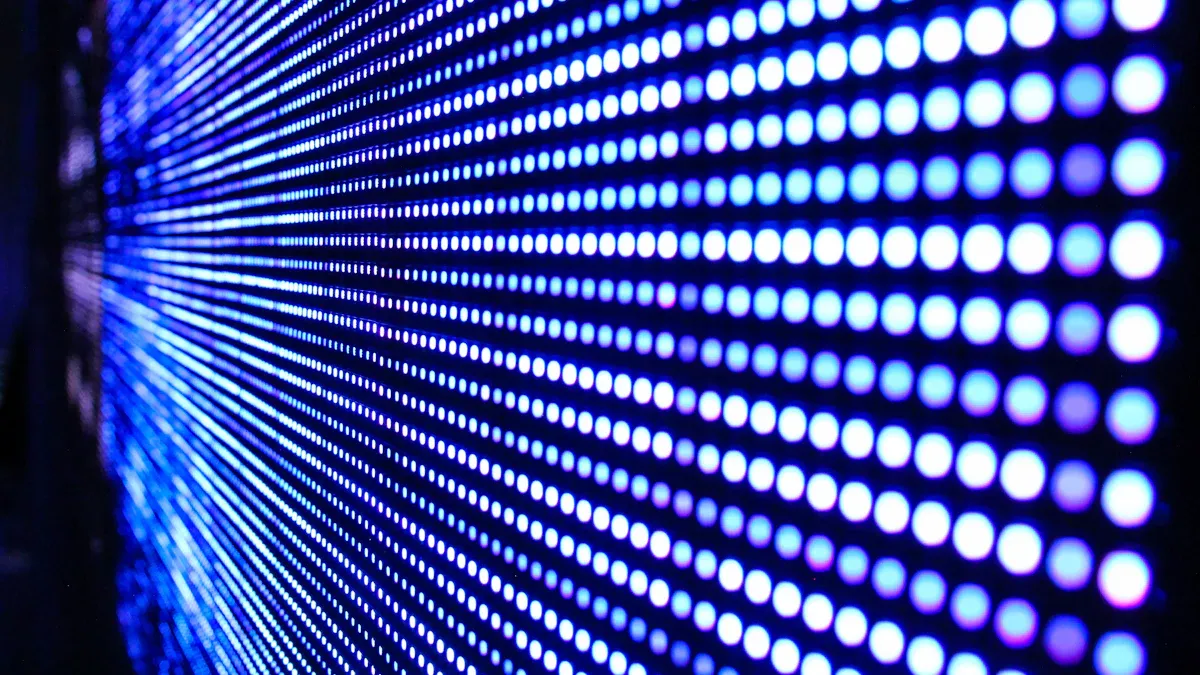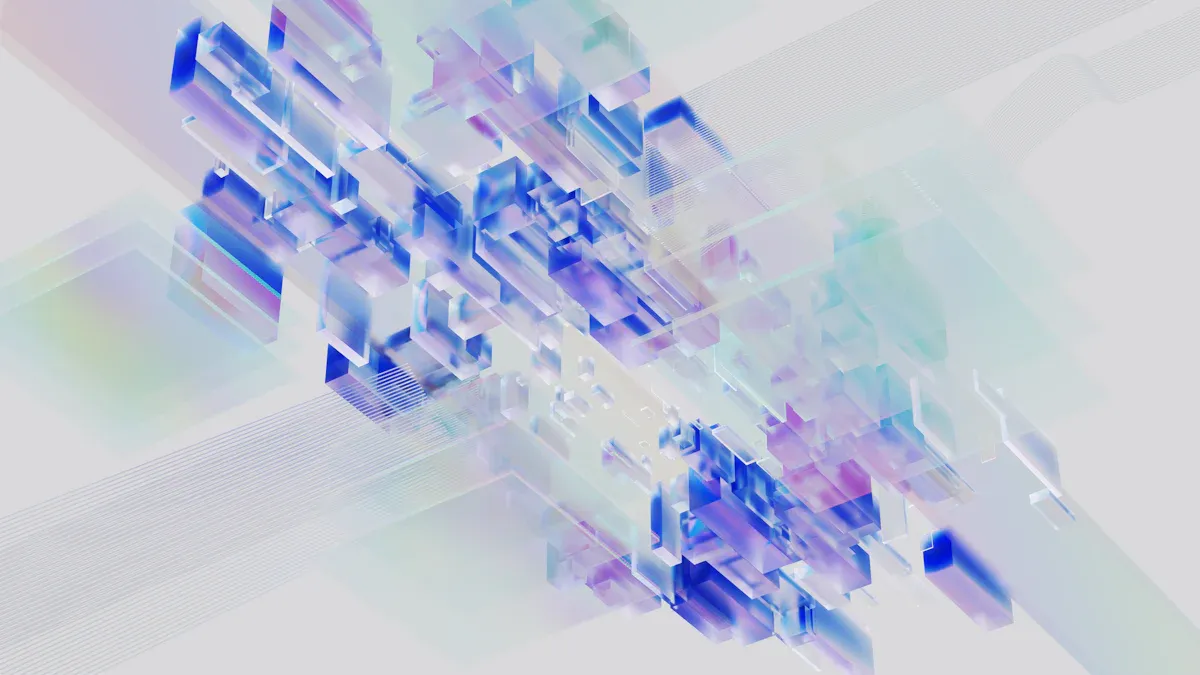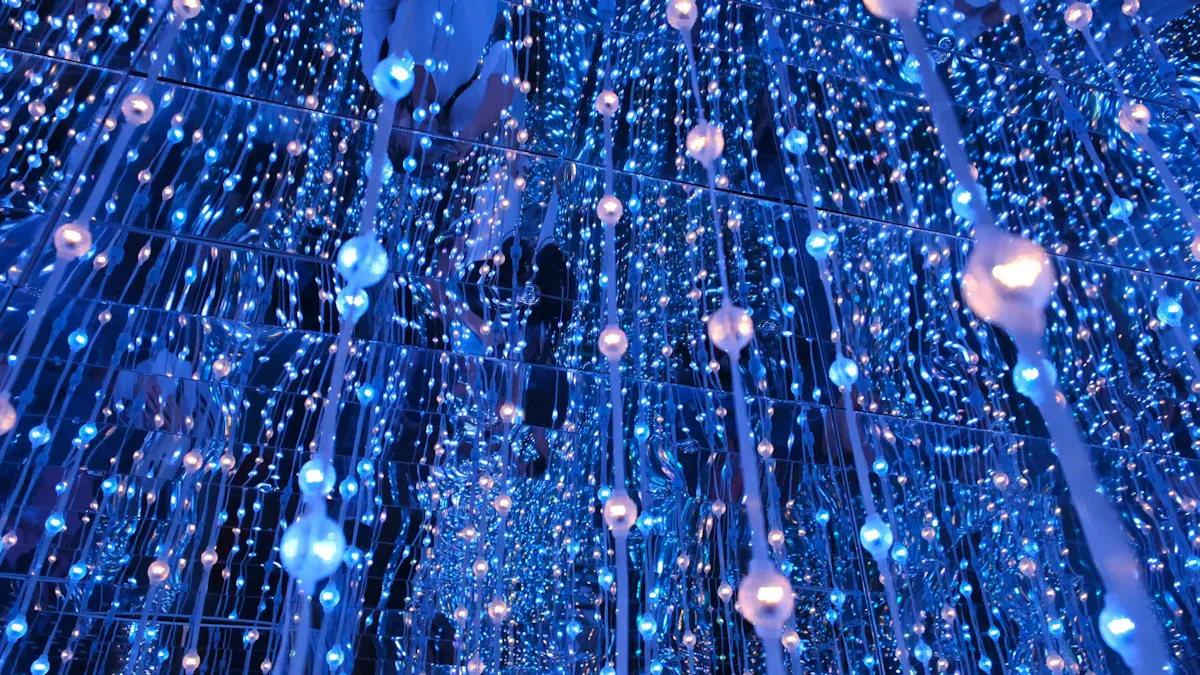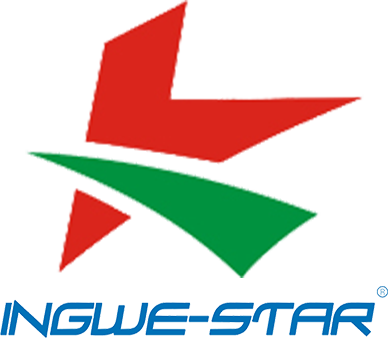Emerging Technologies in LED Display Solutions

The led display industry is changing fast. People want better performance and more eco-friendly options. New led display solutions use advanced technology like microled, flexible displays, and quantum dot integration. These new ideas make displays brighter and save more energy. They also show colors better and last longer. The market for led displays is growing quickly. Many businesses use them in stores and public places. Better user experience, less power use, and cool designs help the led display industry grow. Innovation is very important for its future.
Key Takeaways
New LED display technologies include MicroLED, QLED, and flexible screens. These screens show brighter images and better colors. They last longer and use less energy.
MicroLED displays give sharp and clear pictures. They do not need backlights. This makes them thin and saves energy. They are still expensive to make.
Quantum Dot LED (QLED) screens show bright colors. They work well in places with lots of light. Offices and stores use them often.
Flexible and rollable LED screens can bend and curve. This lets people create cool designs. These screens are strong and good for special spaces.
Smart features like AI, touch, and 5G help LED displays. These features make screens interactive and easy to control. Users find them more fun to use.
MicroLED Displays
Overview
MicroLED technology is a big step forward for LED screens. MicroLEDs are much smaller than regular LEDs. Each one is less than 100 micrometers wide. This tiny size helps make images look sharper and clearer. MicroLED displays have pixels that make their own light. They do not need a backlight. This makes the screens thinner and saves energy. The table below shows how microLED is different from other types:
Feature | Traditional LED | Mini-LED | MicroLED |
|---|---|---|---|
Size | Larger than 200 µm | 100-200 µm | Less than 100 µm |
Application | Various displays | Backlighting, direct-view | Direct-view displays |
Resolution | Standard | Higher | Significantly higher |
Brightness | Standard | Improved | Superior |
Color Accuracy | Standard | Improved | Superior |
Energy Efficiency | Standard | Improved | Superior |
Durability | Standard | N/A | Enhanced |
Lifespan | Standard | N/A | Longer |
Benefits
MicroLED displays have many good points over other screens. They are brighter and show colors more clearly. They also react faster to changes. MicroLED screens use materials that do not burn in. This helps them last longer. They use less power because they do not need a backlight. Each pixel can turn on or off by itself. This gives deep blacks and strong contrast. MicroLED is great for both indoor and outdoor led screen panels.
Applications
MicroLED displays are used in many places. Businesses use them in stores and sports arenas. They are bright and save energy. People see microLED screens in TVs, phones, monitors, and smartwatches. These screens last long and show bright colors. Factories use them in cars, smart cities, hospitals, and schools. These places need strong and flexible screens.
Challenges
MicroLED displays still have some problems. It is hard to make them in a cheap and fast way. Moving tiny LEDs onto screens takes a lot of time and money. This makes microLED TVs very expensive. Some cost more than $100,000. Most people cannot buy them. Other screen types like OLED are also strong rivals. Until making microLED gets easier, it will stay a high-end choice for led screen displays.
Quantum Dot LED (QLED)
Technology
Quantum Dot LED (QLED) technology uses very small particles. These are called quantum dots. They are between 2 and 10 nanometers wide. The size of each dot decides what color it makes. Big dots make red light. Small dots make green or blue light. Most QLED screens have a layer of quantum dots. This layer sits in front of a blue LED backlight. Blue light goes through the quantum dot layer. It changes into pure red and green light. This makes colors look better than regular LCD or LED screens. Some new QLED research looks at self-emissive quantum dots. These could help future 8k displays work even better.
Color and Brightness
QLED screens are known for bright pictures and strong colors. Quantum dots make exact colors when hit by LED backlight. This lets QLED screens be brighter and show colors more clearly than regular LED screens. The quantum dot layer helps show more colors and deeper contrast. QLED screens work well in bright rooms. They are good for places with lots of sunlight. Many 8k screens use QLED panels for lifelike images and great HDR. Quantum dots and LED backlights together make pictures look real and colorful.
Note: QLED screens can show 100% color volume. This means they keep rich colors at any brightness.
Use Cases
QLED screens are used in many places because they last long and work well.
Offices use QLED screens for signs and directions. They catch people’s eyes and work in bright rooms.
Schools pick QLED for classroom screens. They cost less and can be used every day.
Stores use QLED signs to show brands and get customers interested.
Workplaces like QLED more than OLED for meetings and talks. QLED is brighter and lasts longer.
Many homes and businesses use QLED 8k screens for great pictures and steady use.
QLED technology keeps growing in home gadgets and professional led display solutions.
Flexible and Rollable LED

Materials
Flexible and rollable LED displays use special materials for strength and bending. Makers pick flexible printed circuit boards for these screens. These boards let the screens bend and twist without breaking. Soft LED screens use soft PCB materials. This helps them bend and curve easily. Rollable LED screens use flexible materials like PVC. This lets the screen roll up without getting hurt. Plastic substrates are used instead of glass. This makes the screens light and hard to break. Many flexible screens use printed electronics and organic electrochromic materials. These new ideas help the screens stay strong after bending many times and keep prices low.
Flexible PCBs let screens bend and twist.
Soft PCB materials help smooth curves.
PVC lets screens roll up.
Plastic substrates make screens hard to break.
Design Potential
Flexible LED screens give new choices to designers and architects. These screens can bend, fold, or wrap around curved walls and columns. They are light and thin, so they are easy to put up in small spaces. Designers can make curved, round, wave, or special shapes. Flexible LED screens fit odd surfaces and help with creative signs or art. The screens still show bright colors and sharp pictures, even in new shapes. Many stores, event places, and public spots use these screens for cool experiences.
Tip: Flexible LED screens fit well in modern buildings and help with both looks and use.
Durability
Flexible and rollable LED screens are very tough. Plastic substrates make them hard to break, so they can take hits better than glass screens. The materials stop damage from lots of bending and folding. Flexible LED screens keep their picture clear after many bends. Their build helps them last a long time in busy places, like outside ads or crowded areas. They save energy and are built strong, so they are good for businesses that need screens to last.
Interactive LED Display Solutions
Touch and Gesture
Touch and gesture features change how people use LED screens. Touchscreens let people use the screen by tapping or swiping. They can look at products, book things, and find information. Operators can change what is on the screen right away. This keeps messages new and the same everywhere. Automation helps save money. It means less staff and less paper is needed.
Benefit | Description |
|---|---|
Enhanced User Engagement | Touchscreens let people join in. They can look at products, book things, and find information. |
Real-Time Content Control | Operators can change screens fast. This keeps messages new and the same everywhere. |
Lower Operational Costs | Automation means less staff and less paper. This saves money and helps the planet. |
Gesture controls use hand moves to work the screen. These controls help keep screens clean. This is good for hospitals and busy places. People can make words bigger or change languages with simple moves. Games make interactive led screens more fun and easy to remember.
AI Integration
AI adds smart tools to interactive led screens. It uses face and motion tracking to change what is shown. Voice commands let people talk to the screen. AI makes messages special for each group. It tracks how people use the screens. This helps businesses make better displays. AI also changes brightness and color to save power. This helps screens last longer.
AI looks at how people react and changes ads fast.
It makes screens fit each business and place.
AI checks screens from far away and fixes problems quickly.
Data helps companies see what works and plan better.
AI makes new games and moving pictures for screens.
User Engagement
Interactive led screens help people join in many places. In stores, 83% saw more people use these screens. Digital signs helped 55% remember ads and changed 74% of shoppers’ choices. In schools, boards and kiosks made learning more fun and helped students work together. Special messages made people join in 27% more. People waited less in lines and wanted to learn about products. These screens make people want to go into stores and remember brands.
IoT and 5G in LED Displays

Connectivity
IoT and 5G help led displays share information fast. IoT lets screens talk to other devices. They send and get data right away. Operators can change signs from far away. This keeps the content new. 5G gives quick speeds and short wait times. Screens show clear pictures and videos with no delay. Big places use 5G for live events on large led screens. Smart streetlights and public signs use 5G to update fast. These networks help displays work well in busy cities.
Smart Features
New led displays have smart features from IoT and 5G. These features make signs more helpful and fun. Sensors check brightness and temperature. Screens change to fit the room. Operators control screens from anywhere with remote tools. 5G lets many screens show different things at once. AI and AR work with these screens for cool experiences. Stores use live updates for prices and products. Hospitals and schools use smart screens for alerts and learning. These features help screens work for many needs.
Tip: Smart led screens can change messages by time, place, or people nearby. This helps businesses talk to the right crowd.
Streaming in high-definition and interactive content
Signs update in real time
Remote control with cellular routers
AI and AR give special experiences
Outdoor Advertising
IoT and 5G make outdoor ads with led screens stronger. Advertisers use data to show custom messages to groups. 5G lets them change ads fast and control signs from the cloud. AR and voice commands make ads more fun. Energy-saving led screens help companies go green. Outdoor signs use smart tools to count viewers and see how they react. This helps businesses make better plans and get good results.
Trend/Feature | Impact on Outdoor Advertising Strategies and Effectiveness |
|---|---|
AI-Powered Personalization | Uses data for custom content, bringing more people and sales. |
5G Connectivity | Gives real-time updates, cloud control, and easy IoT use. |
AR & Interactive Signage | Makes ads more fun and lets people join in. |
Voice-Activated Displays | Lets people use ads without touching and join more. |
Sustainability | Uses energy-saving led screens and eco-friendly materials. |
All-in-One LED Wall Technologies
Setup
All-in-one led wall technologies make putting up big screens easier. These systems have power, control, and audio in one unit. Companies do not need extra parts or lots of cables. The displays come ready with color set at the factory. No one needs to fix colors by hand at the event. Most setups take only two or three hours. Old video walls can take nine to seventeen hours. People without special training can set up these led display screen rental units. The design skips hard assembly and heavy steel frames. Built-in software lets you control everything from one spot. Some models come in different shapes and sizes. This helps with special events or spaces.
Power and control are built in.
Color is set at the factory.
Fast setup in two or three hours.
No need for lots of cables or steel frames.
Software lets you control from one place.
Maintenance
All-in-one led display screen rental solutions are easy to care for. The design has fewer parts that can break. GOB LED technology uses a strong epoxy resin shield. This shield keeps out dust, water, and bumps. It helps the displays last longer and stay safe in busy places. Companies spend less time and money fixing them. The displays need less cleaning and fewer check-ups. This means less downtime and better service for customers.
Note: Easy care lets businesses focus on their work, not fixing screens.
Business Benefits
Businesses get many good things from all-in-one led display screen rental options. These displays are easy to move and store. Foldable models have wheels and motor stands. This makes moving them simple. Staff can set up the displays in about ten minutes. No special skills are needed. Companies use these displays at trade shows, sports events, and more. The screens look great and give guests a top experience. The all-in-one design has everything needed. No extra equipment is needed. This saves money and time. The strong build and easy care also lower costs over time.
Benefit | Description |
|---|---|
Easy to move and store | Foldable, wheeled, and small for quick moves |
Quick to set up | Ready in minutes, no experts needed |
Good for many events | Works for trade shows, sports, rentals |
Great visuals | Wide color range and smooth screens for better engagement |
Power, control, and audio are included for easy use |
All-in-one led wall technologies help businesses work faster, save money, and give better experiences to their audiences.
E-Paper and Immersive Overlays
E-Paper
E-paper technology is growing fast in the led display world. Companies like TCL now have full-color e-paper signs. These come in sizes from 25.3 inches to 75 inches. Some displays last up to 18 months on one battery. They can refresh thousands of times. Users update them with Bluetooth, Wi-Fi, or 4G. This makes changing content simple. The 28.3-inch model uses new oxide technology. It refreshes faster than older models. E Ink’s 75-inch Spectra™ 6 display is big and colorful. It sets a new standard for eye-friendly, green screens. E-paper is used for office table cards, photo frames, and phone cases. These displays use very little power. They help businesses save energy. E-paper is a good choice for places that need clear images and long-lasting screens.
Immersive LED Overlays
Immersive led overlays change how people see digital content. These overlays use seamless led panels and smart software. They create 360-degree spaces that surround viewers. People feel inside the high-resolution images. This keeps their focus and blocks out distractions. Motion sensors and interactive features let content react to people. Flexible and curved led displays fit special spaces. Any area can become an immersive place. Businesses use these displays for marketing, showrooms, and entertainment. The overlays show bright colors and perfect images. They are also very reliable. Augmented reality and social media let users share what they see right away. Games and personal touches make each visit special. This helps customers remember and enjoy their time.
Tip: Immersive displays help brands tell stories and connect with people in a deeper way.
Energy Efficiency
E-paper and immersive led overlays both save energy. E-paper screens use very little power. Some last over a year on one charge. This is great for places where saving power is important. Immersive led overlays use new materials and smart controls. They lower energy use but keep pictures bright. Sensors change brightness and color to match the room. This saves even more power. Businesses using these screens can spend less money and help the planet.
Sustainability in LED Display Solutions
Low Power
Modern led display solutions use less energy than before. Common Cathode Technology helps save up to 75% more energy. These screens can change their brightness by themselves. They only use the power needed for the room. Low power led screens use 50% to 70% less electricity than old halogen or fluorescent displays. High-efficiency chips turn electricity into bright light with little waste. Smart dimming changes the screen’s brightness when the room gets lighter or darker. This saves power without anyone having to do anything. All these things help businesses spend less money and make less pollution.
Sustainability Aspect | Benchmark / Feature Description |
|---|---|
Power Consumption | Up to 75% energy savings using Common Cathode Technology; auto-adjustable brightness optimizes energy use |
Energy Efficiency | LED displays consume significantly less power than traditional LCD or projection displays |
Product Lifespan | Longer lifespans reduce electronic waste and material consumption |
Certifications | ENERGY STAR®, EPEAT Gold, TCO Certified validate sustainability claims |
Eco Materials
Now, companies use eco-friendly materials to make led displays. They use recycled plastics and bio-based polymers from plants like cornstarch, cellulose, and algae. This helps cut down on new plastic and lowers greenhouse gases. Some companies mix recycled glass with plant-based plastics to make strong panels. Enbon uses plastics like PVC and polyethylene. These are safe and do not hurt people or the planet. These materials make led screens tough for inside and outside. Other materials like wood, cardboard, paper, glass, fabric, and metal are also used. These choices help the screens last longer and be recycled.
Tip: Picking displays made with recycled or plant-based materials helps companies go green and look good to customers.
Recycling
Recycling programs for led displays are growing. Special electronics recyclers take apart screens and save useful parts. These recyclers are certified by groups like e-Stewards® or R2. Many companies let customers send back old screens for recycling. Local waste programs also take led screens as electronic waste. Companies like ViewSonic teach workers about being green and pick suppliers who care about the planet. These actions help cut down on waste and support recycling.
Location | Recycling Program / Facility Link | Description / Notes |
|---|---|---|
Vermont | http://dec.vermont.gov/waste-management/solid/product-stewardship/electronics | State electronic recycling program and facility listings |
Virginia | https://www.deq.virginia.gov/our-programs/land-waste/recycling/statewide-recycling-programs/computer-electronics-recycling | Statewide computer and electronics recycling program; ViewSonic recovered electronics in 2024 |
Washington | http://www.ecy.wa.gov/programs/swfa/eproductrecycle/index.html | E-waste management program |
West Virginia | E-waste management and consumer information | |
Wisconsin | Electronics recycling and collection site information |
New technology in led display solutions is changing the industry a lot. New ideas help make screens brighter and colors look better. These changes also help screens last longer. Better led display solutions are good for the planet and help people use them more. Learning about these new things helps businesses pick the best screens.
If you want new led display solutions, experts say to do these things:
Talk to display experts for advice.
Think about what you need now and later.
Keep an eye on new technology and trends.
FAQ
What makes MicroLED displays different from OLED screens?
MicroLED displays use very small LEDs for each pixel. They are brighter and last longer than OLED screens. OLED screens use organic materials instead. MicroLEDs do not burn in easily. They show sharper pictures. Many businesses pick MicroLED because it is tough and saves energy.
How do quantum dots improve color in LED displays?
Quantum dots make colors by giving off certain light waves. This helps screens show colors more clearly and brightly. QLED screens show strong reds, greens, and blues. People see real-looking pictures in both bright and dark places.
Are flexible LED screens suitable for outdoor use?
Flexible LED screens use strong plastic layers. These layers help them stand up to hits and bad weather. Many outdoor signs and event screens use flexible LEDs. These screens bend and last a long time in busy places.
What role does AI play in interactive LED displays?
AI changes what is on the screen for each person. It also checks how people use the screen. AI changes brightness and color to save power. Businesses use AI to see how people react. AI lets people use voice and hand moves to control the screen.
How can companies recycle old LED displays?
Companies send old screens to special recyclers. Many states have programs for e-waste. Recyclers take out useful parts and cut down on trash. Recycling helps the planet more than throwing screens away.

